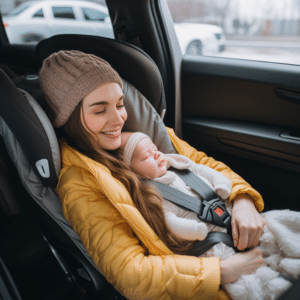
Soothing Newborns in Car Seats: Strategies and Solutions
Introduction
To understand why newborns cry in car seats, let’s delve into the introduction. Gain insight into this common issue and discover the possible reasons behind these cries. Explore each sub-section – “Understanding the issue: Why do newborns cry in car seats?” – for comprehensive solutions.
Understanding the issue: Why do newborns cry in car seats?

Newborns crying in car seats is a common problem. It can be due to discomfort, nausea, or feeling overwhelmed by the new environment. To help, make sure the seat is properly fitted and adjusted. Playing calming music or white noise can provide reassurance. Frequent stops can help reduce discomfort and provide opportunities for feeding or changing diapers if needed. Each baby is unique, so patience and empathy are key. This will help make car journeys a more pleasant experience for everyone.
Strap your newborn in a car seat for safety, but just remember they won’t be able to provide directions if you get lost!
Safety considerations for using car seats with newborns
To ensure the safety of your newborn while traveling, equip yourself with the right knowledge and tools. Selecting the correct car seat, installing it properly, and addressing common misconceptions are crucial steps. Discover the importance of choosing the right car seat, learn the techniques for proper installation and secure fit, and gain insights into addressing common concerns about car seat safety.
Importance of selecting the right car seat for newborns
Choosing the perfect car seat for a newborn is essential for their safety when travelling in a car. Here’s why:
- Correct placement: A proper car seat makes sure the baby is positioned correctly, reducing the danger of injuries.
- Protection from impact: A good car seat provides protection from possible impacts or crashes.
- Secure restraint: Newborns must be firmly held in a car seat to stop them from being thrown about in case of sudden braking or accidents.
- Support and comfort: An apt car seat provides plenty of support and comfort to keep the newborn relaxed while travelling.
- Fits baby’s size and age: Each car seat is designed to accommodate specific age groups, including newborns, to ensure a secure fit and safety features.
- Easier installation: Choosing the right car seat means a simpler installation process, allowing parents to focus on their child’s welfare more quickly.
Plus, there are other things to think about when choosing the ideal car seat for a newborn. Such as, ease of cleaning, compatibility with strollers, and adjustable features.
Did you know, according to Consumer Reports, almost 59% of child seats are wrongly used? This shows how important it is to pick the correct car seat for your newborn’s safety.
Putting the car seat up correctly and making sure it has a secure fit is like trying to fold a fitted sheet while juggling flaming swords – hard, but essential for your newborn’s safety.
Proper installation techniques and ensuring a secure fit
Car seats are vital for newborns when travelling in cars. To make sure they work well, you must use the right installation techniques and make sure they fit securely. Here’s a helpful guide:
- Position: Put the car seat in the backseat, facing backwards. Ensure it is reclined at a 45 degree angle to support the baby’s spine and airway. Use the built-in level indicators or put rolled towels under it if needed.
- Secure Installation: Use either the vehicle’s seat belt or LATCH system to install the car seat. Follow the manufacturer’s instructions exactly, as each model may have particular requirements.
- Tighten & Test: After installing, tighten the straps firmly, making sure they are flat and not twisted. Do a quick test by tugging on different parts of the car seat to see if it moves more than an inch in any direction.
Also, remember the following special details to maximize safety:
- Avoid bulky clothing or blankets between the baby and harness straps, as this can weaken their effectiveness in an accident.
- Check for recalls and register your car seat to stay informed about any possible safety issues or updates.
- Always replace a car seat after an accident, even if no damage is visible.
For further security, here are some tips:
- Ask for Professional Help: If you’re not sure about the installation, talk to a certified child passenger safety technician who can help you.
- Inspect & Maintain Regularly: Check your car seat every so often for any signs of wear or damage, such as frayed straps or cracked plastic parts. Clean it following the manufacturer’s guidelines without damaging it.
By following these tips and understanding how each one works, you can make sure your newborn is safe in their car seat – giving you peace of mind when travelling. Car seat safety is like wearing a seatbelt for babies – it’s not about looking fashionable, it’s about saving lives.
Addressing common concerns and misconceptions about car seat safety
Car seat safety is a must for protecting babies during travel. Let’s look at common questions and ideas around this.
- Rear-Facing Position: This supports their undeveloped necks and heads, so they are safe in case of stops or accidents.
- Restraining Straps: These straps keep the baby snug and safe from injury.
- Avoid Bulky Clothing: This interferes with the straps, so use thin layers or blankets.
- Correct Installation: Follow the instructions and get help if needed.
You must also maintain and inspect car seats regularly, and be aware of the weight limits.
NHTSA found rear-facing car seats five times safer than forward-facing ones for under two-year-olds. Proper balance between baby comfort and car seat position is tricky, but it’s worth it for safety.
Comfort and positioning for newborns in car seats
To ensure the comfort and positioning of your newborn in a car seat, address each challenge with the following solutions: choosing the right car seat for their comfort, adjusting the seat’s recline angle to support their head and neck, and providing extra support and cushioning for added comfort during the ride.
Choosing the most suitable car seat for newborns’ comfort
Choose a car seat that is specifically designed for newborns, ensuring a snug fit and maximum support. Look for ample padding to absorb shocks and vibrations during travel. Select a seat with adjustable head and body supports, which will keep your baby’s spine properly aligned. Soft and breathable fabric will keep your baby cool and comfy on long journeys. Ensure the car seat offers multiple recline positions so you can find the optimal angle for your baby’s comfort. Opt for a seat that is easy to install and adjust, plus any unique features like side-impact protection or compatibility with strollers if they fit with your needs. Invest in your baby’s comfort – an informed decision is key to ensure safety and luxury!
Adjusting the seat’s recline angle to support newborns’ head and neck
For newborns, adjusting the car seat’s recline angle is essential to provide the proper support for their delicate head and neck. Follow these steps to ensure their comfort and safety:
- Position the car seat – rear-facing, as per manufacturer instructions.
- Locate the recline adjustment lever/knob.
- Adjust the recline angle – a more reclined position for newborns is best.
- Check for proper positioning – ensure their head is in line with their body and no gaps between their head and the backrest.
Remember to use an infant insert or padding from the car seat manufacturer for added support. Also, check on your baby regularly while driving to make sure they’re comfortable and positioned correctly.
Following these adjustments and guidelines will help ensure your newborn receives the best care and protection during car rides. VIP treatment all the way – extra support and cushioning for a luxurious ride, even over those pothole-ridden streets!
Providing additional support and cushioning for extra comfort
Look out, parents! Cushions and inserts specifically designed for newborns can provide the necessary support for their delicate bodies, preventing their heads from flopping forward. Straps and harnesses allow for a snug, secure and comfortable fit. Extra padding or foam inserts offer a cozy environment, reducing discomfort and fatigue. Accessorize with neck pillows and shoulder strap covers to prevent irritation and rubbing.
Always adhere to the manufacturer’s guidelines for optimal safety. With these extra supportive measures, we can make every ride a pleasant one for our precious bundles of joy. Buckle up and make car rides as enjoyable as a day at the spa!
Strategies to soothe a crying newborn in a car seat
To help soothe a crying newborn in a car seat, address the situation by creating a calm and soothing environment, incorporating familiar and comforting items, and using gentle stimulation and distraction techniques. These solutions will assist in alleviating the distress of your little one during car rides.
Creating a calm and soothing environment inside the car
Driving with a crying newborn can be quite stressful. To create a soothing atmosphere, try these suggestions:
- Keep the temperature comfy. Not too hot, not too cold.
- Play soft music. Fill the air with gentle melodies or lullabies.
- Use window shades. Shield your baby from harsh sunlight or distractions.
- Reduce noise levels. Close windows or use soundproof covers.
- Create a cozy atmosphere. Use blankets or soft pillows for comfort.
- Talk softly or sing. Engage with your little one or soothe them with music.
Newborns in Car Seats, It is important to remember details that can further enhance the calming environment. Avoid rapid acceleration or abrupt braking, and plan trips during nap time.
To understand why these strategies work, it’s important to note why they’re effective. Keeping a comfortable temperature stops your baby from getting overheated or chilled. Soft music stimulates their auditory senses. Window shades reduce external stimuli and create privacy. Reducing noise levels prevents overstimulation. Cozy atmosphere helps with any discomfort caused by the car seat. Talking or singing provides a familiar and comforting sound.
By implementing these strategies and understanding their significance, you can create a calming atmosphere in the car. Plus, adding your baby’s favorite stuffed animal won’t hurt either!
Incorporating familiar and comforting items within the car seat
Make car rides comfortable and enjoyable for your precious little one. Incorporate familiar items, such as:
- Soft blankets or stuffed animals.
- Familiar scents (like parents’ clothing or baby lotion).
- Gentle music or white noise.
- Baby-safe mirrors.
- Pacifiers or teething toys.
- Reversible car seat inserts.
These will provide a sense of security and make traveling more pleasant.
Follow the manufacturer’s guidelines and recommendations when selecting accessories.
Forget the car radio – let your newborn’s cries be the soundtrack of your road trip adventure!
Techniques for providing gentle stimulation and distraction
Gently stimulating and distracting a crying newborn in a car seat can create a calm atmosphere. These strategies can make car rides enjoyable for all:
- Play soft music: Rhythmic tunes can relax and take their attention away from any discomfort. Pick soothing lullabies or instrumental melodies.
- Use sensory toys: Place toys near the car seat, within reach. Different textures, colors, and sounds will captivate their interest.
- Talk or sing softly: Babies find comfort in familiar voices. Speak or sing in a calm tone, sharing stories or melodies they love.
- Massage their hands: Gently massage their tiny fingers and palms. This provides tactile stimulation and promotes relaxation.
These techniques work because soft music replicates the womb’s soundscape that babies find cosy. Sensory toys offer distractions from discomfort. Speaking or singing brings familiarity of loved ones’ voices.
By increasing stimulation and providing gentle distractions, newborns can feel calmer during car rides. Implementing these strategies can turn stressful journeys into peaceful moments!
Practical tips for traveling with a newborn in a car seat
To ensure a smooth and comfortable journey for your newborn in a car seat, tackle practical tips by planning breaks and considering the journey duration, ensuring proper feeding and burping beforehand, and managing temperature and humidity levels inside the car.
Planning breaks and considering the duration of the journey
A mother wanted to go on a road trip with her newborn. So, she planned. Here’s how:
- Calculate the time it’ll take to get to her destination, factoring in distance, traffic, and stops. This will give her an idea of the total travel time and allow her to plan breaks.
- Plan short breaks for 1-2 hours. This will give her baby a chance to stretch, feed, or have a diaper change. Mom can also use these stops to rest, grab a snack, or use restroom facilities.
- Look for places along the route with amenities suitable for babies, like clean restrooms with changing stations or playgrounds. This will save time and make the journey smoother.
- Be ready to adjust plans if needed. Have alternate routes or plans in mind.
In addition, it’s important to stay informed about road conditions. That way, the mother can make sure her baby is happy in the car – no screaming. And with that, they can embark on their adventure!
Ensuring proper feeding and burping before placing the newborn in the car seat
Feed your newborn! Start by offering them a meal, making sure they have enough milk or formula to last during the ride.
Allow digestion time before placing them in the car seat. This reduces the risk of regurgitation or spitting up.
Hold them upright against your chest or shoulder. Pat gently on their back to help induce a burp. Support their head and neck. Wait for a satisfactory burp.
These steps are essential for comfort and safety during travel. They also reduce potential health risks such as choking.
Many parents don’t realize the importance of proper feeding and burping, but personal experiences shared by others show why it’s important. For instance, a friend once shared how her newborn cried throughout a long road trip because she hadn’t burped them before.
Keep your little one comfortable this summer by following the right feeding and burping practices when traveling!
Managing temperature and humidity levels inside the car

Remember, keeping the car comfy for your newborn is essential. It can affect their sleep and mood during travel.
A study in Pediatrics Journal showed that babies exposed to high temps in cars have an increased risk of heat-related illnesses.
So, take care to ensure they stay cool on the go. Here’s how:
- Control airflow: Adjust the car’s vent to maintain an optimal temp and humidity. This will stop extreme temps from affecting your little one.
- Use window shades: Put sunshades on the windows to block out excess sunlight and heat. This will keep your baby safe from UV rays and also make the car cooler.
- Monitor dressing: Dress your baby in light, breathable clothing that allows air circulation. Avoid overdressing or heavy blankets as they raise body heat.
Strap your baby in the car seat with all the love and care of an Ikea furniture assembly!
Conclusion: Helping your newborn feel calm and secure in a car seat
- If your newborn is crying in a car seat, there are ways to help. Use an infant insert to keep them comfy, and adjust the straps so they’re not too tight.
- To create a cozy environment, use a car seat canopy or cover.
- Also, distract them with toys, soft music, or lullabies.
- Lastly, check for the root cause of their distress, like hunger, dirty diapers, or tiredness. If their needs are met, they’ll be content during travel.